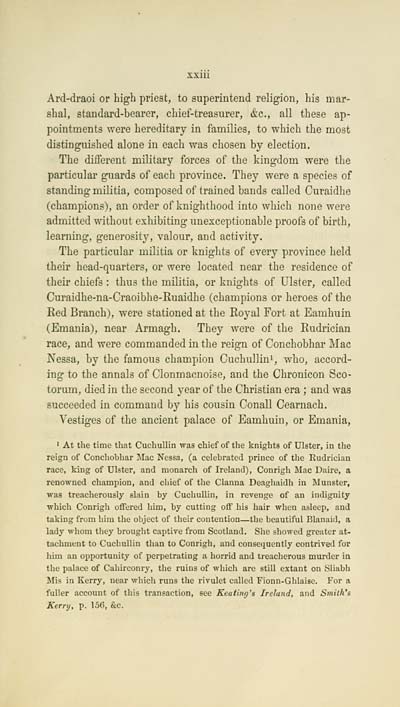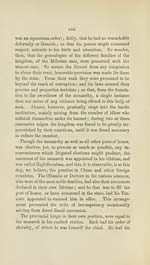Download files
Complete book:
Individual page:
Thumbnail gallery: Grid view | List view

Ard-draoi or high priest, to superintend religion, his mar-
shal, standard-bearer, chief- treasurer, &c., all these ap-
pointments were hereditary in families, to which the most
distinguished alone in each was chosen by election.
The different military forces of the kingdom were the
particular guards of each province. They were a species of
standing militia, composed of trained bands called Curaidhe
(champions), an order of knighthood into which none were
admitted without exhibiting unexceptionable proofs of birth,
learning, generosity, valour, and activity.
The particular militia or knights of every province held
their head-quarters, or were located near the residence of
their chiefs : thus the militia, or knights of Ulster, called
Curaidhe-na-Craoibhe-Ruaidhe (champions or heroes of the
Red Branch), were stationed at the Royal Fort at Eamhuin
(Emania), near Armagh. They were of the Rudrician
race, and were commanded in the reign of Conchobhar Mac
Nessa, by the famous champion Cuchullini, who, accord-
ing to the annals of Clonmacnoise, and the Chronicon Sco-
torum, died in the second year of the Christian era ; and was
succeeded in command by his cousin Conall Cearnach.
Vestiges of the ancient palace of Eamhuin, or Emania,
' At the time that Cuchullin was chief of the knights of Ulster, in the
reign of Conchobhar Mac Nessa, (a celebrated prince of the Rudrician
race, king of "Ulster, and monarch of Ireland), Conrigh Mac Daire, a
renowned champion, and chief of the Clanna Deaghaidh in Munster,
was treacherously slain by Cuchullin, in revenge of an indignity
which Conrigh offered him, by cutting off his hair when asleep, and
taking from him the object of their contention — the beautiful Blanaid, a
lady whom they brought captive from Scotland. She showed greater at-
tachment to Cuchullin than to Conrigh, and consequently contrived for
him an opportunity of perpetrating a horrid and treacherous murder in
the palace of Cahirconry, the ruins of which are still extant on Sliabh
Mis in Kerry, near which runs the rivulet called Fionn-Ghlaise. For a
fuller account of tliis transaction, see Keating's Ireland, and Smith's
Kerry, p. 156, &c.
shal, standard-bearer, chief- treasurer, &c., all these ap-
pointments were hereditary in families, to which the most
distinguished alone in each was chosen by election.
The different military forces of the kingdom were the
particular guards of each province. They were a species of
standing militia, composed of trained bands called Curaidhe
(champions), an order of knighthood into which none were
admitted without exhibiting unexceptionable proofs of birth,
learning, generosity, valour, and activity.
The particular militia or knights of every province held
their head-quarters, or were located near the residence of
their chiefs : thus the militia, or knights of Ulster, called
Curaidhe-na-Craoibhe-Ruaidhe (champions or heroes of the
Red Branch), were stationed at the Royal Fort at Eamhuin
(Emania), near Armagh. They were of the Rudrician
race, and were commanded in the reign of Conchobhar Mac
Nessa, by the famous champion Cuchullini, who, accord-
ing to the annals of Clonmacnoise, and the Chronicon Sco-
torum, died in the second year of the Christian era ; and was
succeeded in command by his cousin Conall Cearnach.
Vestiges of the ancient palace of Eamhuin, or Emania,
' At the time that Cuchullin was chief of the knights of Ulster, in the
reign of Conchobhar Mac Nessa, (a celebrated prince of the Rudrician
race, king of "Ulster, and monarch of Ireland), Conrigh Mac Daire, a
renowned champion, and chief of the Clanna Deaghaidh in Munster,
was treacherously slain by Cuchullin, in revenge of an indignity
which Conrigh offered him, by cutting off his hair when asleep, and
taking from him the object of their contention — the beautiful Blanaid, a
lady whom they brought captive from Scotland. She showed greater at-
tachment to Cuchullin than to Conrigh, and consequently contrived for
him an opportunity of perpetrating a horrid and treacherous murder in
the palace of Cahirconry, the ruins of which are still extant on Sliabh
Mis in Kerry, near which runs the rivulet called Fionn-Ghlaise. For a
fuller account of tliis transaction, see Keating's Ireland, and Smith's
Kerry, p. 156, &c.
Set display mode to: Large image | Transcription
Images and transcriptions on this page, including medium image downloads, may be used under the Creative Commons Attribution 4.0 International Licence unless otherwise stated. ![]()
| Early Gaelic Book Collections > J. F. Campbell Collection > Transactions of the Ossianic Society > Volume 4 > (27) |
|---|
| Permanent URL | https://digital.nls.uk/82289727 |
|---|
| Description | Dublin : Printed under the direction of the Council, 1854-1861. |
|---|---|
| Shelfmark | Cam.1.c.5-10 |
| Additional NLS resources: | |
| Description | Volumes from a collection of 610 books rich in Highland folklore, Ossianic literature and other Celtic subjects. Many of the books annotated by John Francis Campbell of Islay, who assembled the collection. |
|---|
| Description | Selected items from five 'Special and Named Printed Collections'. Includes books in Gaelic and other Celtic languages, works about the Gaels, their languages, literature, culture and history. |
|---|

